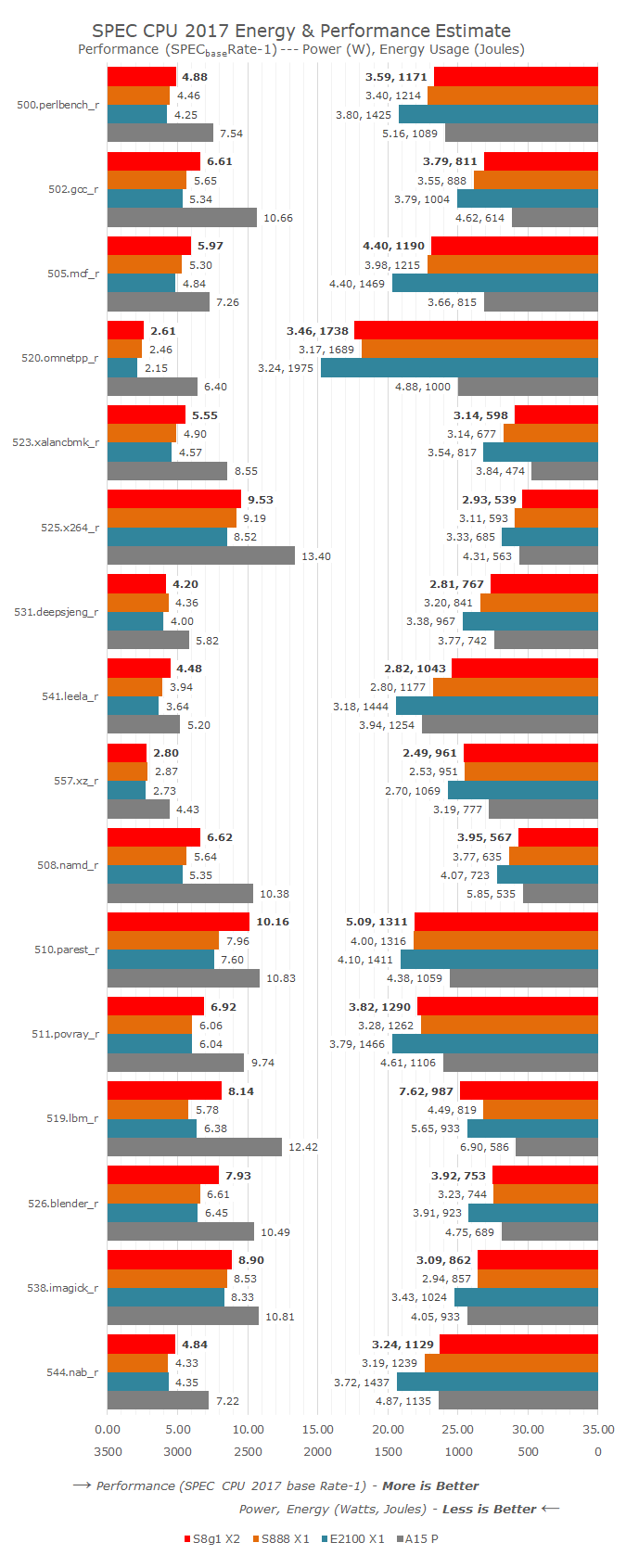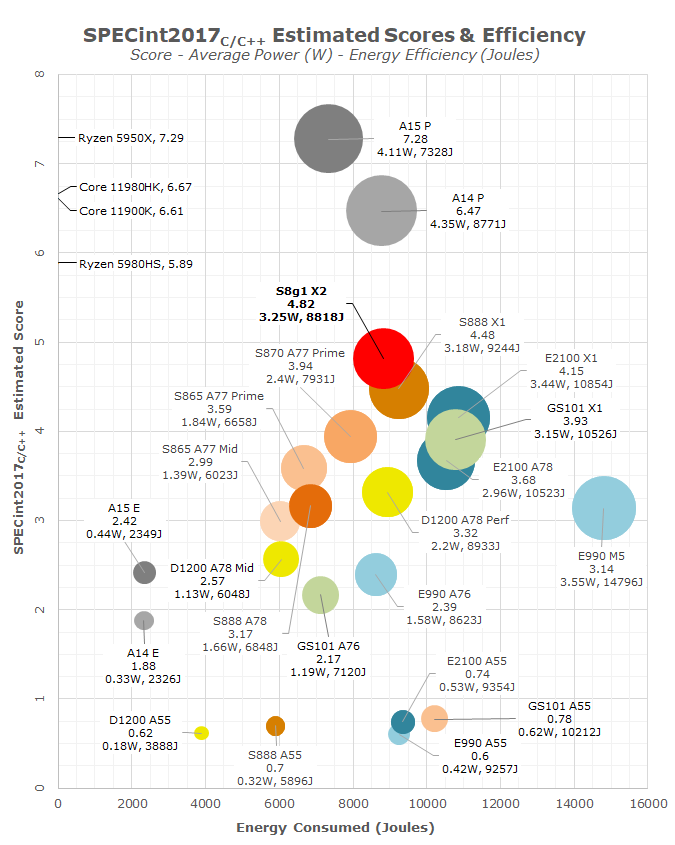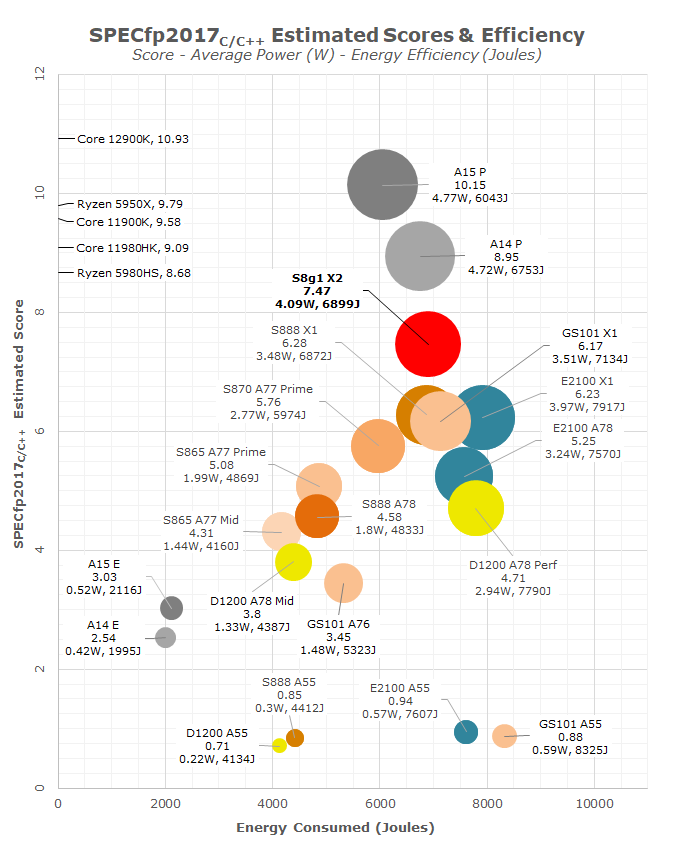The Snapdragon 8 Gen 1 Performance Preview: Sizing Up Cortex-X2
by Dr. Ian Cutress on December 14, 2021 8:00 AM ESTTesting the Cortex-X2: A New Android Flagship Core
Improving on the Cortex-X1 by switching to the Arm v9 architecture and increasing the core resources, both Arm and Qualcomm are keen to promote that the Cortex-X2 offers better performance and responsiveness than previous CPU cores. The small frequency bump from 2.85 GHz to 3.00 GHz will add some of that performance, however the question is always if the new manufacturing process coupled with the frequency increase allows for better power efficiency when running these workloads. Our standard analysis tool here is SPEC2017.
Running through some of these numbers, there are healthy gains to the core, and almost everything has a performance lift.
On the integer side (from 500.perlbench to 557.xr), there are good gains for gcc (+17%), mcf (+13%), xalancbmk (+13%), and leela (+14%), leading to an overall +8% improvement. Most of these integer tests involve cache movement and throughput, and usually gains in sub-tests like gcc can help a wide range of regular user workloads.
Looking at power and energy for the integer benchmarks, we’re seeing the X2 consume more instantaneous power on almost all the tests, but the efficiency is kicking in. That overall 8% performance gain is taking 5% less total energy, but on average requires 2% more peak power.
If we put this core up against all the other performance cores we test, we see that 8% jump in performance for 5% less energy used, and the X2 stands well above the X1 cores of the previous generation, especially those in non-Snapdragon processors. There is still a fundamental step needed to reach the Apple cores, even the previous-generation A14 performance core, which scores 34% higher for the same energy consumed (albeit on average another 34% peak power).
Just on these numbers, Qualcomm’s +20% performance or +30% efficiency doesn’t bare fruit, but the floating point numbers are significantly different.
Several benchmarks in 2017fp are substantially higher on the X2 this generation. +17% on namd for example would point to execution performance increases, but +28% in parest, +41% in lbm and +20% in blender showcases a mix of execution performance and memory performance. Overall we’re seeing +19% performance, which is nearer Qualcomm’s 20% mark. Note that this comes with an almost identical amount of energy consumed relative to the X1 core in the S888, with a difference of just 0.2%.
The major difference however is the average power consumed. For example, our biggest single test gain in 519.lbm is +41%, but where the S888 averages 4.49 watts, the new X2 core averages 7.62 watts. That’s a 70% increase in instantaneous power consumer, and realistically no single core in a modern smartphone should draw that much power. The reason why the power goes this high is because lbm leverages the memory subsystem, especially that 6 MiB L3 cache and relies on the 4 MiB system level cache, all of which consumes power. Overall in the lbm test, the +41% performance costs +20% energy, so efficiency is still +16% in this test. Some of the other tests, such as parest and blender, also follow this pattern.
Comparing against the competition, the X2 core does make a better generation jump when it comes to floating point performance. It will be interesting to see how other processors enable the X2 core, especially MTK’s flagship at slightly higher frequency, on TSMC N4, but also if it has access to a full 14 MiB combination of caches as we suspect, that could bring the power draw during single core use a lot higher. It will be difficult to tease out exactly who wins what where based on implementation vs. process node, but it will be a fun comparison to make when we look purely at the X2 vs. X2 cores.
Unfortunately due to how long SPEC takes to run (1h30 on the X2), we were unable to test on the A710/A510. We’ll have to wait to see when we get a retail unit.













169 Comments
View All Comments
eastcoast_pete - Wednesday, December 15, 2021 - link
As of now, and assuming Mediatek doesn't screw up the firmware, the Dimensity 9000 would best QC's "flagship" mobile SoC for 2022. Now, I remember reading that no major smartphone maker plans to sell phones with the Dimensity 9000 in the US, at least not officially. Is that really so, and if yes, does anyone here know why? I gladly do without the mm wave 5G channels (the 9000 doesn't cover those), which are really only available on Verizon, and even then only in some places.TheinsanegamerN - Friday, December 17, 2021 - link
Dimensity has no support for Verizon, which means you lose about 40% of the US market from the get go.Wardrive86 - Wednesday, December 15, 2021 - link
Excellent article Ian! Those geekbench scores are extremely close to my tigerlake i5-1135g7 in fullsize notebook. Extremely impressive, look forward to sustained performance testing and comparisons to mediatekTheinsanegamerN - Friday, December 17, 2021 - link
How many times does it need to be pointed out that geekbench is worthless for comparisons across systems? Unless you are doing ARM android VS ARM android or the like, the scores are not representative of real world performance.Comparing ARM android to x86 windows is like comparing an apple to a medieval sword. Totally different use cases.
Wilco1 - Saturday, December 18, 2021 - link
How many times does it need to be pointed out the scores are directly comparable? It compilers the same benchmark source code using LLVM whenever possible and runs the same datasets. There are differences between OSes of course, but that only affects scores in a minor way.And it's not like Geekbench scores show a completely different picture from SPEC results - modern phones are really as fast as laptops.
Wardrive86 - Sunday, December 19, 2021 - link
Agreed Wilco, it may not stress the memory subsystems to the extent that SPEC does, but it seems to paint roughly the same picture.IUU - Monday, February 7, 2022 - link
"modern phones are really as fast as laptops."No they are not. You will inever beat the physical law. The only reason some Android or iOS devices have reached to the point of being comparable with laptops or desktops is because they have managed for the first time in history to grab some superior lithographies first
If that was not the case , laptops and desktops would be x3 to x15 faster than today's mobile devices. But if laptops nad desktops sold at 700 to 2000 dollars then how would smartphones be sold at today's prices ? The comparison would be abysmal.
So the industry found a solution. Keep desktops and laptops at ancient lithographies while grab for android and iOS the best of the best.
Then con
IUU - Monday, February 7, 2022 - link
then convince the sheeple that they somehow live in a revolution of better and most economical devices while keeping them at the same level of computing capacity for the best part of the decade. Not only that , but also get tons of dollars for selling a dream....IUU - Monday, February 7, 2022 - link
I accept both geekbench AND antutu for making a quick comparison between mobile devices(and yes I know the qualms about Antutu but I think they are hysterical. And geekbench for making quick comparisons between platforms, having in the back of my mind their limitations, always.Before the mobile devolution came we had a very clear picture of the computational capacity of our chips. Then the radicals came being secretive about their chips. So , though we still have a gross impression of the theoretical performance of desktop and laptop chips we are in the dark concerning the "mobile" . As far as I am concerned I take their claims with a huge grain of salt.
Good guys don't hide....
ChrisGX - Wednesday, December 15, 2021 - link
On these numbers the Snapdragon 8 Gen 1 doesn't appear to be living up the 4x AI perf claim. Is there more performance to come? We will know soon enough but even without any further improvement in the AI scores the SD8 Gen 1 still looks pretty good.With the SD8 Gen 1 and the MediaTek Dimensity 9000 posting good AI scores (unconfirmed in the case of the D9000) we can expect Google and even Apple to start raising the stakes on the AI performance of future silicon. Qualcomm, too, is going to have to lift its game with MediaTek looking very competitive in so many areas.